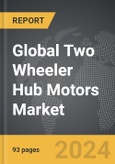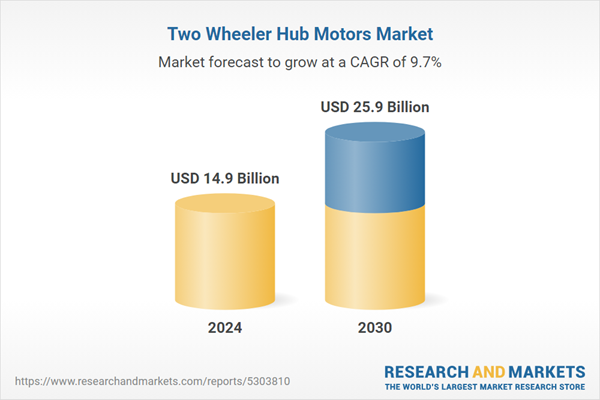Global Two-Wheeler Hub Motors Market - Key Trends & Drivers Summarized
What Are Two-Wheeler Hub Motors, and Why Are They So Crucial for Electric Mobility?
Two-Wheeler Hub Motors are electric motors integrated into the wheel hubs of two-wheelers, such as electric scooters, motorcycles, and bicycles. These motors directly drive the wheels, eliminating the need for traditional drivetrains like chains, belts, or gearboxes. This design not only simplifies the vehicle's construction but also increases efficiency by minimizing energy loss during power transmission. Hub motors can be mounted on either the front or rear wheel, with some high-performance models using a dual-motor setup for greater power and traction. Hub motors are known for their compact size, lightweight design, and high torque output, making them essential components in the electric two-wheeler industry, which is rapidly growing due to increased demand for sustainable urban mobility solutions.The importance of two-wheeler hub motors extends beyond their mechanical advantages. As cities face rising pollution levels and increased congestion, electric two-wheelers are becoming a preferred mode of transport due to their zero emissions, affordability, and ease of use. Hub motors play a vital role in this transition by enabling manufacturers to produce cost-effective, low-maintenance electric two-wheelers that appeal to both commuters and delivery fleets. Additionally, hub motors contribute to the growing trend of shared mobility services, as they offer a durable and efficient solution for electric scooters used in ride-sharing programs. This simplicity and efficiency have made two-wheeler hub motors a central technology in the global shift toward cleaner, more sustainable transportation solutions, driving demand across developed and emerging markets.
How Are Technological Advancements Shaping the Evolution of the Two-Wheeler Hub Motors Market?
Technological advancements are transforming the Two-Wheeler Hub Motors market, leading to innovations in design, performance, and efficiency. Improvements in motor materials, such as high-performance magnets and advanced laminations, have increased the power density of hub motors while reducing their weight. These advancements enhance acceleration, climbing capabilities, and overall performance of electric two-wheelers, making them more competitive with traditional petrol-powered counterparts. Additionally, the development of brushless direct current (BLDC) hub motors has reduced maintenance requirements, improved efficiency, and extended the lifespan of electric two-wheelers. The shift toward BLDC motors, which offer better thermal management and quieter operation, has become a key trend in the market, further improving the user experience.Another significant advancement is the integration of smart control systems and IoT (Internet of Things) connectivity in hub motors. These systems allow for features like regenerative braking, which recaptures energy during deceleration to extend the vehicle's range, and advanced torque control for smoother rides. IoT-enabled hub motors can provide real-time diagnostics, performance monitoring, and predictive maintenance alerts, improving safety and reducing operational costs for fleet operators. Furthermore, the development of modular hub motor designs has enabled easier scalability for manufacturers, allowing for quick customization based on vehicle type, battery capacity, and performance requirements. These technological innovations are not only driving the adoption of two-wheeler hub motors but also enhancing their efficiency, making them a more attractive option for both individual consumers and fleet operators.
What Are the Emerging Applications of Two-Wheeler Hub Motors Across Different Segments?
The applications of Two-Wheeler Hub Motors are expanding rapidly across different segments, driven by growing demand for electric mobility in both consumer and commercial markets. In the consumer segment, hub motors are widely used in electric scooters, mopeds, and bicycles, offering a clean, efficient, and affordable alternative to petrol-powered vehicles. Commuters in urban areas increasingly prefer electric two-wheelers for short-distance travel due to lower running costs, reduced emissions, and ease of parking. Hub motors also enable manufacturers to design compact, lightweight models that are suitable for riders of all ages, further broadening their appeal. In addition, the adoption of electric bicycles, particularly e-bikes with pedal assist, has gained momentum as more consumers seek eco-friendly fitness options and recreational activities.In the commercial segment, hub motors are becoming essential for electric delivery scooters used by last-mile delivery companies, e-commerce platforms, and food delivery services. Hub motor-equipped electric two-wheelers are favored by fleet operators due to their low maintenance, high durability, and reduced total cost of ownership, making them ideal for daily commercial use. Shared mobility services, such as electric scooter rental programs, also rely heavily on hub motor technology for its reliability, ease of use, and lower energy consumption. Additionally, advancements in high-torque hub motors are enabling the development of electric motorcycles capable of longer ranges and faster speeds, catering to both urban commuters and adventure riders. As demand for electric mobility solutions grows across various sectors, two-wheeler hub motors are finding broader applications, reflecting their versatility and critical role in driving the electrification of personal and commercial transportation.
What Drives Growth in the Two-Wheeler Hub Motors Market?
The growth in the Two-Wheeler Hub Motors market is driven by several factors, including rising demand for electric mobility, government incentives for electric vehicles (EVs), and increasing environmental concerns. One of the primary growth drivers is the global push toward reducing carbon emissions and achieving net-zero targets, prompting governments to offer subsidies, tax benefits, and rebates for electric two-wheelers. These incentives have made electric scooters and bikes more affordable for consumers, boosting the demand for hub motors. Additionally, rapid urbanization and the need for efficient urban transport have increased the adoption of electric two-wheelers as a convenient and cost-effective solution to congested city streets. Hub motors, with their simplicity and reliability, have become the preferred choice for manufacturers aiming to cater to this growing demand.Moreover, advancements in battery technology, such as increased energy density and faster charging capabilities, have made electric two-wheelers more viable for daily use, supporting the demand for efficient hub motors. The growing popularity of shared mobility services, including electric scooter rentals and ride-hailing, is also contributing to market growth, as fleet operators seek low-maintenance, durable, and energy-efficient solutions for large-scale deployment. Additionally, the rise of e-commerce and last-mile delivery has accelerated the adoption of hub motor-powered electric delivery scooters, further driving the market. As electric mobility becomes more mainstream and infrastructure improves, the two-wheeler hub motor market is expected to experience sustained growth, supported by technological innovations and increasing consumer awareness of sustainable transportation.
Report Scope
The report analyzes the Two Wheeler Hub Motors market, presented in terms of units. The analysis covers the key segments and geographic regions outlined below.Segments: Installation Type (Rear Hub Motor, Front Hub Motor); Motor (Geared Hub Motor, Gearless Hub Motor); Power Output (Below 1 kW, (1-3) kW, Above 3 kW).
Geographic Regions/Countries: World; United States; Canada; Japan; China; Europe (France; Germany; Italy; United Kingdom; Spain; Russia; and Rest of Europe); Asia-Pacific (Australia; India; South Korea; and Rest of Asia-Pacific); Latin America (Argentina; Brazil; Mexico; and Rest of Latin America); Middle East (Iran; Israel; Saudi Arabia; United Arab Emirates; and Rest of Middle East); and Africa.
Key Insights:
- Market Growth: Understand the significant growth trajectory of the Rear Hub Motor segment, which is expected to reach US$23.8 Billion by 2030 with a CAGR of a 10.0%. The Front Hub Motor segment is also set to grow at 6.6% CAGR over the analysis period.
- Regional Analysis: Gain insights into the U.S. market, valued at $3.8 Billion in 2024, and China, forecasted to grow at an impressive 13.9% CAGR to reach $6.7 Billion by 2030. Discover growth trends in other key regions, including Japan, Canada, Germany, and the Asia-Pacific.
Why You Should Buy This Report:
- Detailed Market Analysis: Access a thorough analysis of the Global Two Wheeler Hub Motors Market, covering all major geographic regions and market segments.
- Competitive Insights: Get an overview of the competitive landscape, including the market presence of major players across different geographies.
- Future Trends and Drivers: Understand the key trends and drivers shaping the future of the Global Two Wheeler Hub Motors Market.
- Actionable Insights: Benefit from actionable insights that can help you identify new revenue opportunities and make strategic business decisions.
Key Questions Answered:
- How is the Global Two Wheeler Hub Motors Market expected to evolve by 2030?
- What are the main drivers and restraints affecting the market?
- Which market segments will grow the most over the forecast period?
- How will market shares for different regions and segments change by 2030?
- Who are the leading players in the market, and what are their prospects?
Report Features:
- Comprehensive Market Data: Independent analysis of annual sales and market forecasts in US$ Million from 2024 to 2030.
- In-Depth Regional Analysis: Detailed insights into key markets, including the U.S., China, Japan, Canada, Europe, Asia-Pacific, Latin America, Middle East, and Africa.
- Company Profiles: Coverage of players such as Elaphe Propulsion Technologies Ltd., GO SwissDrive AG, Heinzmann GmbH and Co. KG, MAC Shanghai Electric Motor Company Ltd, Michelin Group and more.
- Complimentary Updates: Receive free report updates for one year to keep you informed of the latest market developments.
Some of the 42 companies featured in this Two Wheeler Hub Motors market report include:
- Elaphe Propulsion Technologies Ltd.
- GO SwissDrive AG
- Heinzmann GmbH and Co. KG
- MAC Shanghai Electric Motor Company Ltd
- Michelin Group
- NTN Corporation
- Protean Electric
- QS Motor
- Robert Bosch GmbH
- Schaeffler Technologies AG and Co. KG
- Taizhou Quanshun Motor Co., Ltd.
- TDCM Corporation Ltd.
Tariff Impact Analysis: Key Insights for 2025
Global tariff negotiations across 180+ countries are reshaping supply chains, costs, and competitiveness. This report reflects the latest developments as of April 2025 and incorporates forward-looking insights into the market outlook.The analysts continuously track trade developments worldwide, drawing insights from leading global economists and over 200 industry and policy institutions, including think tanks, trade organizations, and national economic advisory bodies. This intelligence is integrated into forecasting models to provide timely, data-driven analysis of emerging risks and opportunities.
What’s Included in This Edition:
- Tariff-adjusted market forecasts by region and segment
- Analysis of cost and supply chain implications by sourcing and trade exposure
- Strategic insights into geographic shifts
Buyers receive a free July 2025 update with:
- Finalized tariff impacts and new trade agreement effects
- Updated projections reflecting global sourcing and cost shifts
- Expanded country-specific coverage across the industry
Table of Contents
Companies Mentioned (Partial List)
A selection of companies mentioned in this report includes, but is not limited to:
- Elaphe Propulsion Technologies Ltd.
- GO SwissDrive AG
- Heinzmann GmbH and Co. KG
- MAC Shanghai Electric Motor Company Ltd
- Michelin Group
- NTN Corporation
- Protean Electric
- QS Motor
- Robert Bosch GmbH
- Schaeffler Technologies AG and Co. KG
- Taizhou Quanshun Motor Co., Ltd.
- TDCM Corporation Ltd.
Table Information
| Report Attribute | Details |
|---|---|
| No. of Pages | 93 |
| Published | April 2025 |
| Forecast Period | 2024 - 2030 |
| Estimated Market Value ( USD | $ 14.9 Billion |
| Forecasted Market Value ( USD | $ 25.9 Billion |
| Compound Annual Growth Rate | 9.7% |
| Regions Covered | Global |









